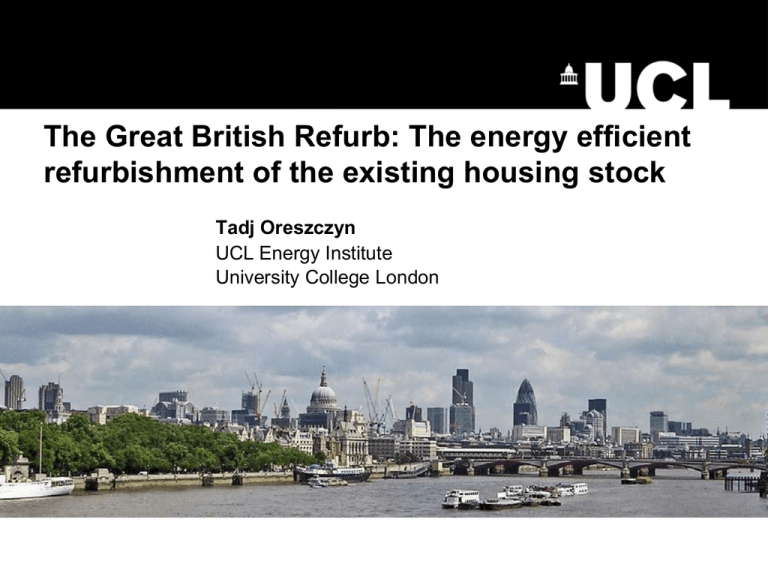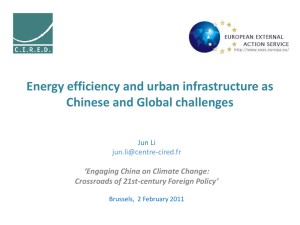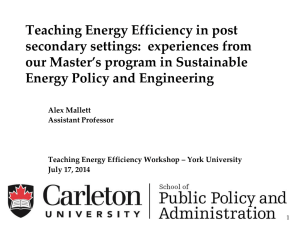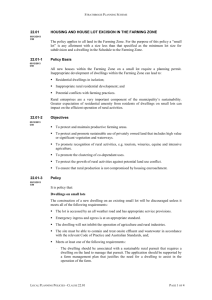Professor Tadj Oreszczyn`s presentation (MS PowerPoint)
advertisement

The Great British Refurb: The energy efficient refurbishment of the existing housing stock Tadj Oreszczyn UCL Energy Institute University College London 12.5° C 12 11 S P 01 10 9 8 7 7.0° C Existing domestic buildings are key to tackling climate change • “Worldwide, 30-40% of all primary energy is used in buildings.” “In Europe, buildings account for 40-45% of energy consumption in society“, UNEP 2007 • the Climate Change Bill mandates an 80% reduction in UK’s CO2 emissions by 2050 • UK domestic homes responsible for 27% of the UK’s GHG emissions, • 80% of this is for space and water heating. • 70% of UK homes will still be here in 2050 • Need energy efficient buildings for other reasons: – Comfort and health – fuel poverty – Security of energy supply What are the options? http://www.eco-hometec.co.uk/Ground%20Source%20Heat%20Pumps.htm Reducing heat loss http://www.whispertech.co.nz/content/library/WTL026Brochure.pdf Efficient heating cooling and energy generation PROBLEM SOLVED ? Camden Victorian Low Carbon Refurbishment 80% carbon reduction (Code Level 4) Code Level 6 (Zero Carbon) new house Barratt’s Greenhouse Zero Carbon House, Code Level 6 (2008) Superinsulated Houses (1985) http://www.thimkagain.co.uk/mk/past-projects.htm http://www.bsjonline.co.uk/Journals/Builder_Group/B uilding_Services_Journal/July_2007/attachments/Dia gram.pdf 23 years The challenge: How to deploy appropriate technology to 24 million dwellings within a complex socio-economic system to reduce carbon emissions by 80% - The Great British Refurb • We have more evidence than we need that technology alone will not deliver • Technology can play a significant part in the solution or the problem. A schematic representation of the inter-relationships between occupant behaviour and other factors in influencing energy use in domestic buildings. Energy usage and occupant behaviour: understanding sociotechnical interactions, Summerfield 2008 Why do we find energy use in buildings difficult? • Energy is used in complex ways, see diagram • Difficult to measure and interpret– Fuel bills are erratic and difficult to interpret – Everything changes e.g. climate – Fuel prices have dropped in real terms and relative to other items (3% for 2000 to 2006 of household expenditure – half of 1980). Average UK house powered by humans £400,000 per annum minimum wage The Great British Refurb: Government Heat consultation 2009 ‘our aim is that by 2030 all homes and other buildings will have received a ‘whole-house’ package of measures that covers all of the cost-effective energy efficiency measures available for that property at the time, as well as renewable heat and electricity measures needed to meet our renewable energy aims. ‘ The greatest engineering challenge this century? Postcode Sector Average Dwelling Age vs Average Gas Consumption per Dwelling 30000 25000 y = -75.102x + 167672 R2 = 0.4126 kWh per year 20000 15000 10000 5000 0 1920 1930 1940 1950 1960 1970 1980 1990 Mean Year of Construction 2000 2010 2020 2030 Postcode Sector Average Dwelling Age vs Average Gas Consumption per Dwelling 30000 25000 y = -75.102x + 167672 R2 = 0.4126 kWh per year 20000 15000 10000 5000 0 1920 1930 1940 1950 1960 1970 1980 1990 Mean Year of Construction 2000 2010 2020 2030 Postcode Sector Average Dwelling Age vs Average Gas Consumption per Dwelling 30000 25000 y = -75.102x + 167672 R2 = 0.4126 kWh per year 20000 15000 10000 zero carbon for all energy 5000 0 1920 1930 1940 1950 1960 1970 1980 1990 Mean Year of Construction 2000 2010 2020 2030 Postcode Sector Average Dwelling Age vs Average Gas Consumption per Dwelling 30000 25000 y = -75.102x + 167672 R2 = 0.4126 kWh per year 20000 The Great British Refurb 2030 15000 10000 5000 zero carbon for all energy 0 1920 1930 1940 1950 1960 1970 1980 1990 Mean Year of Construction 2000 2010 2020 2030 What is Warm Front ? • Targeted at vulnerable (elderly and young) fuel poor • In 2007/8, Warm Front received £350 million funding, allowing the Scheme to assist almost 270,000 households; Warm Front • • • • • Increases temperature in living and bedrooms Improves comfort Reduces fuel cost Reduces mould As a consequence it improves mental health and should reduce winter deaths • But what does it do to energy use? Mean energy use rises by 34%! ‘In theory, theory and practice are the same, but in practice, Santa Fe Institute in Factor Four they’re not’ Why is theory and practice not the same in this case ? 1. Applied physics wrongly 2. Not built/refurbished as modelled/theory 3. Do not understand changes in occupant behaviour PHYSICS APPLIED INCORRECTLY: COMPARISON OF AIR INFILTRATION RATE PRE- AND POST-WARM FRONT Pre-Warm Front Post-Warm Front WF Scheme N Infiltration rate (m3/hr/m2) N Infiltration rate (m3/hr/m2) % Change All properties 78 17.7 (s.d. 7.1) 143 17.0 (s.d. 7.2) -4% w/o CH 22 19.1 (s.d. 7.8) 51 16.5 (s.d. 7.3) -14% w/ CH 56 17.1 (s.d. 6.8) 92 17.2 (s.d. 7.2) +1% Stamford Brook – thermal envelope defects – convective bypasses (Lowe et al 2007) Not refurbished as modelled/theory 20% cavity wall missing in insulation (n = 85) 13% loft area missing in insulation (n = 85) Stamford Brook – thermal envelope defects (www.leedsmet.ac.uk/as/cebe/projects/stamford/summary.htm) Changes in occupant behaviour • Benefit of insulation taken as increased thermal comfort and not reduction in energy use “Rebound effect”, “Take Back”, “Comfort Factor”, “Take off” • People interact with complex systems in complex ways Theoretical boiler efficiency is not being achieved + “…very high proportion of tenants (80%) used some combination of gas fire and central heating.” (Energy efficient modernisation of housing: a UK case study, Bell, Lowe, 2000) Health and the Great British Refurb Before the refurb • 20,000 excess winter deaths, • 4,000 excess summer (2003) • 40 per annum from carbon monoxide • Mould and dust mites After the refurb (depends on occupant behaviour) • Reduced CO and winter excess • Summer deaths may increase unless we take care • Dust mites could increase if we do not take care • Need to reduce other sources of pollution formaldehyde The Great British Refurb: • Essential – big changes • The greatest engineering challenge this century • Will not be easy or cheap – but cheaper and easier than alternatives • Requires socio-technical advances • Real verification (smart meters, Domestic MOT, etc) • Major and rapid changes in research, education, supply chains, contracting, etc • Development of a ~ £10 billion per annum refurb industry • Care in terms of future changes to health and impact of climate change • Must go hand in hand with other policies to achieve target reductions in emissions, e.g. Rise in fuel prices, regulation, decarbonisation of supply ,etc. Fuel and Electricity (Heating) (Control) (Amendment) Order 1980, SI 1013, London: • This revision of the 1974 statutory HMSO, 1984 instrument lowered the maximum heating limit to 19ºC and it applies with certain exemptions to all buildings not used for living accommodation. Buildings affected by the new limit include public buildings. This Order allows the temperature in one part of a building to exceed the maximum limit if this is a necessary consequence of ensuring that the temperature throughout the building exceeds the appropriate statutory minimum. Energy future IEA Technologies Perspective 2008 Energy efficiency 49% MK 1990 – MK 2006 Energy Usage by Fuel at Text 5°C Electricity +70% 160 35 140 30 120 25 100 20 kWh kWh Gas 80 15 60 10 40 5 20 0 0 All Low Mid 1990 2006 High All Low Mid 1990 2006 High THANK YOU Further practical information • Sustainable Energy Academy-Old home SuperHomes http://www.sustainableenergyacademy.org.uk/index.php • Low Energy Victorian House http://www.levh.org.uk/ • Energy Saving Trust http://www.energysavingtrust.org.uk/ Every little helps ? LESS ENERGY NO REBOUND MORE ENERGY EFFICIENT Every little helps ? LESS ENERGY WITH REBOUND MORE ENERGY EFFICIENT Every little helps ? LESS ENERGY WELL HEATED NO REBOUND MORE ENERGY EFFICIENT









